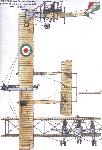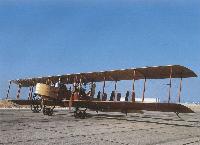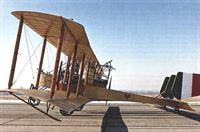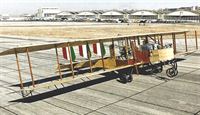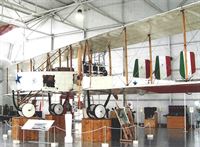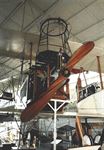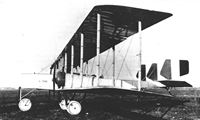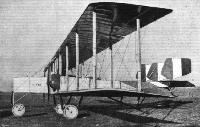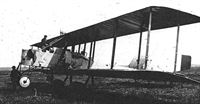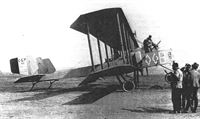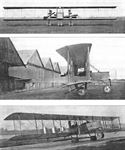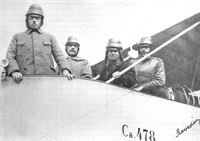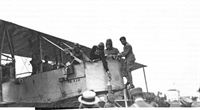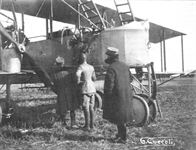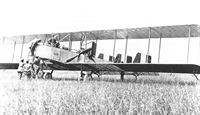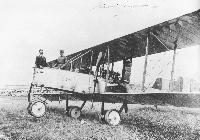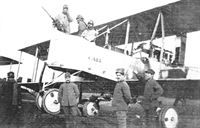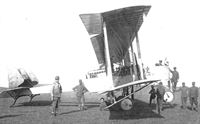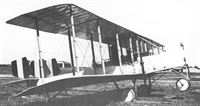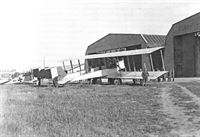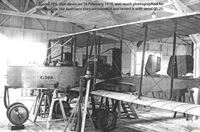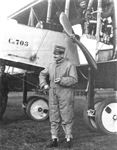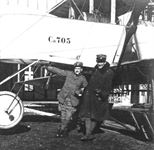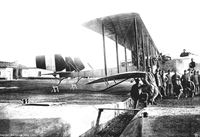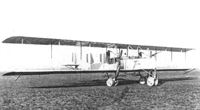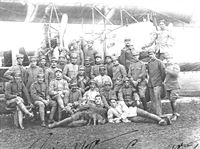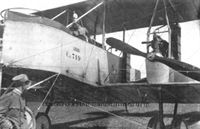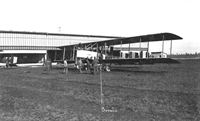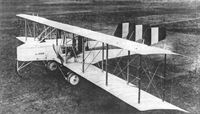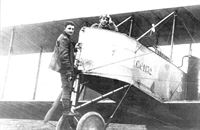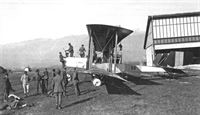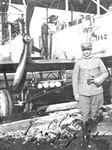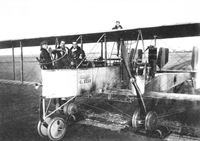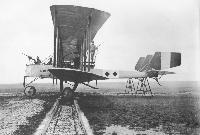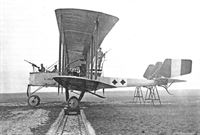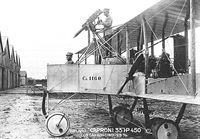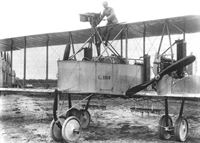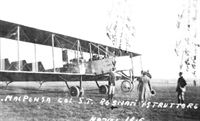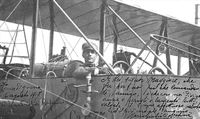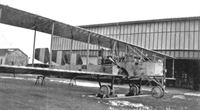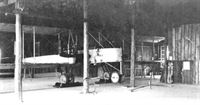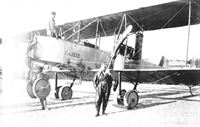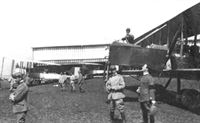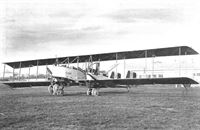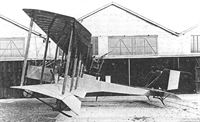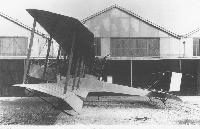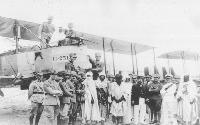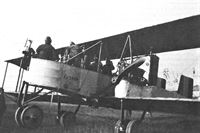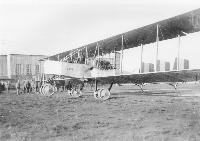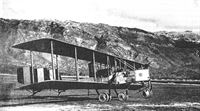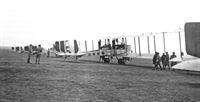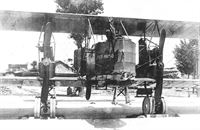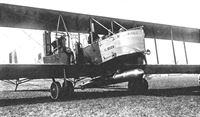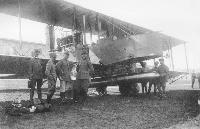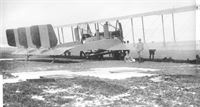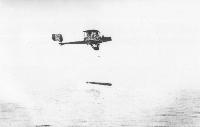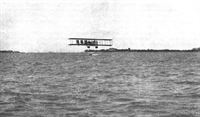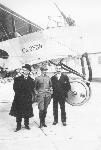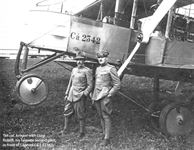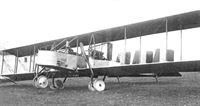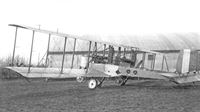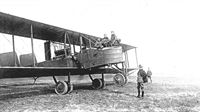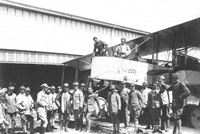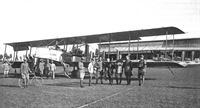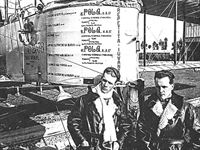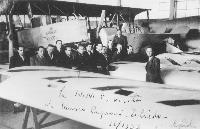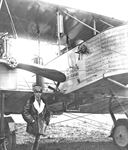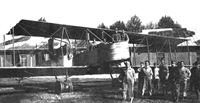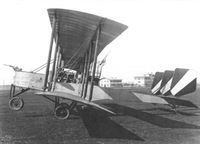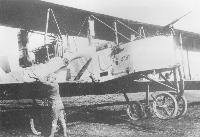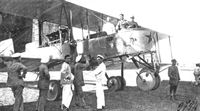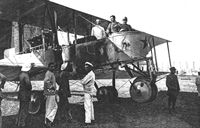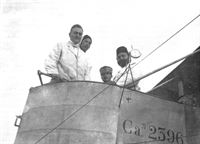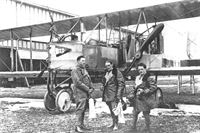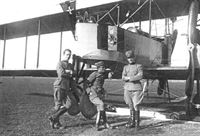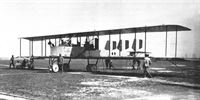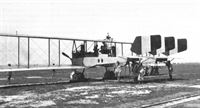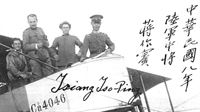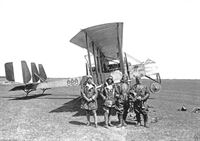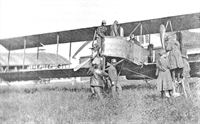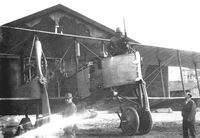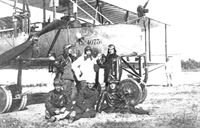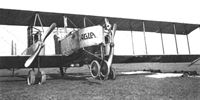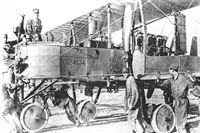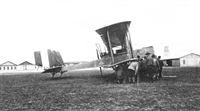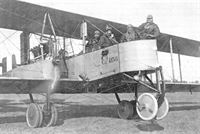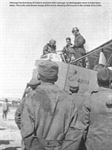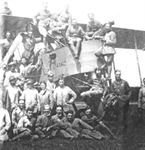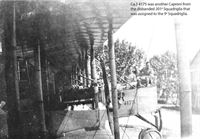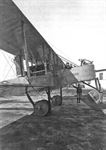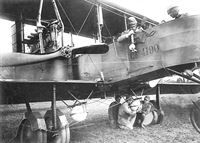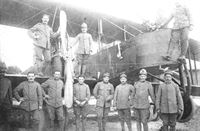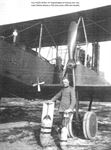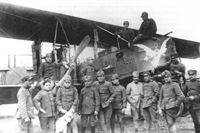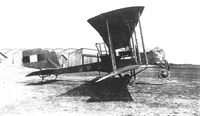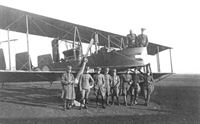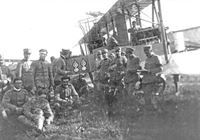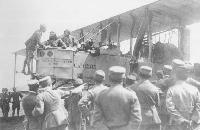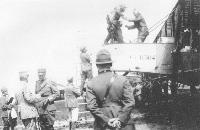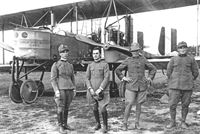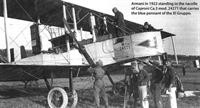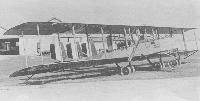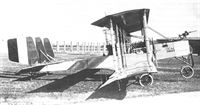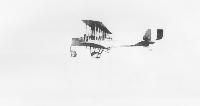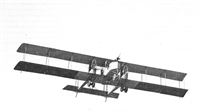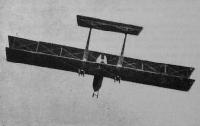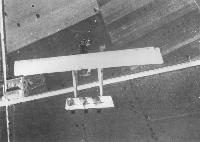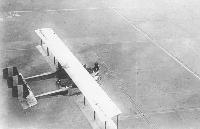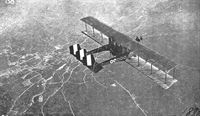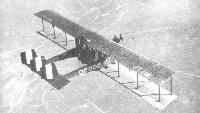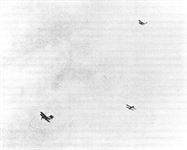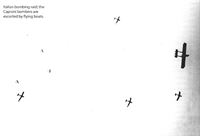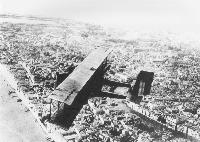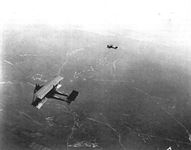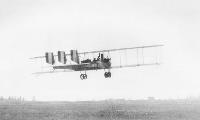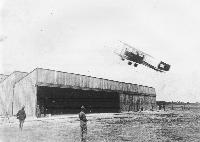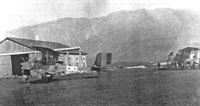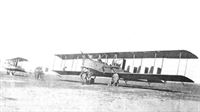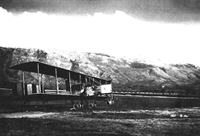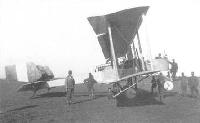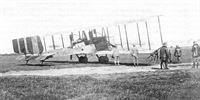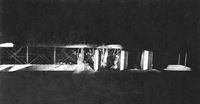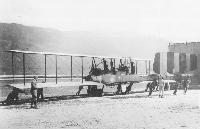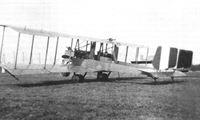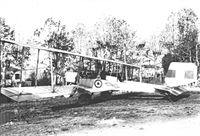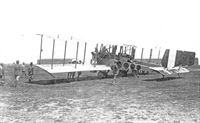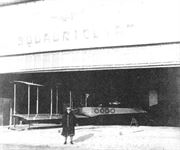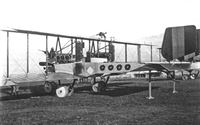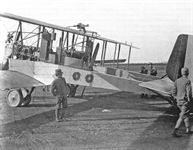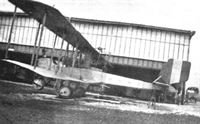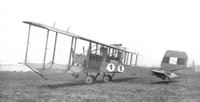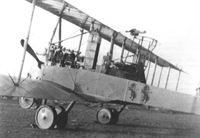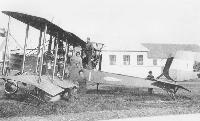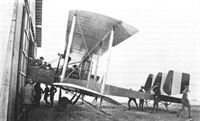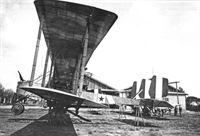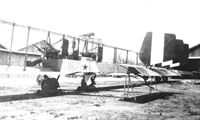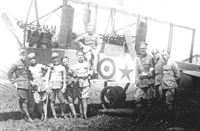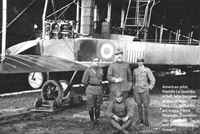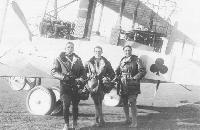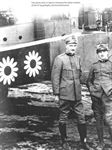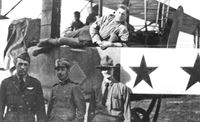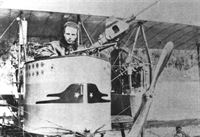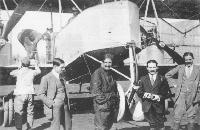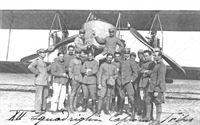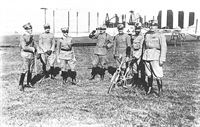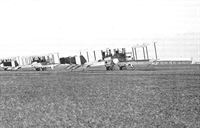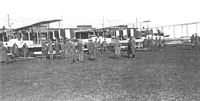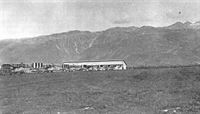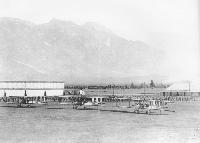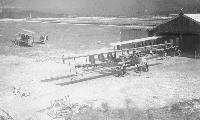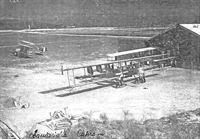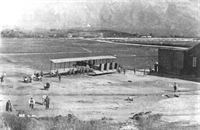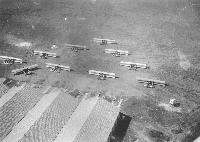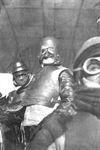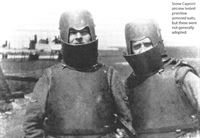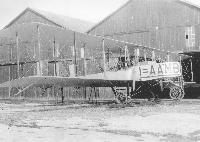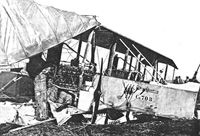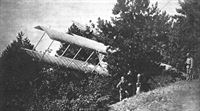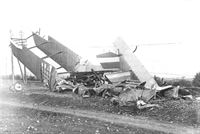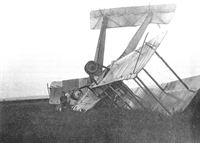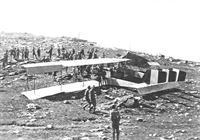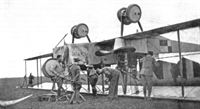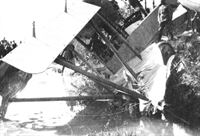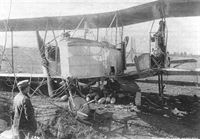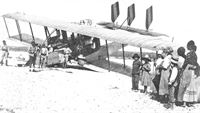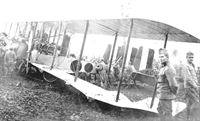
Описание
Страна: Италия
Год: 1914
Бомбардировщик
Варианты
- Caproni - Ca.1 - Ca.3 (Ca.30 - Ca.36) - 1914 - Италия
- Caproni - Ca.5 (Ca.44 - Ca.47) - 1917 - Италия
- В.Кондратьев Самолеты первой мировой войны
- А.Шепс Самолеты Первой мировой войны. Страны Антанты
- R.Abate,G.Alegi,G.Apostolo Aeroplani Caproni: Gianni Caproni and His Aircraft, 1910-1983
- J.Davilla Italian Aviation in the First World War. Vol.2: Aircraft A-H (A Centennial Perspective on Great War Airplanes 74)
- J.Davilla, A.Soltan French Aircraft of the First World War (Flying Machines)
-
R.Gentilli - Italian Aviation Units in the First World War. Vol.1 /Aeronaut/ (1)
Caproni Ca.1 #1136, 3a Squadriglia, Ca. 1916
-
J.Davilla - Italian Aviation in the First World War. Vol.2: Aircraft A-H /Centennial Perspective/ (74)
Caproni Ca.1 #1136, 3a Squadriglia
-
J.Davilla - Italian Aviation in the First World War. Vol.2: Aircraft A-H /Centennial Perspective/ (74)
Caproni Ca.1 #1151, 8a Squadriglia
-
R.Gentilli - Italian Aviation Units in the First World War. Vol.1 /Aeronaut/ (1)
Caproni Ca.1 #1151, 8a Squadriglia, crew Pagliano, Gori, Barbarisi, La Comina, 1917
-
R.Gentilli - Italian Aviation Units in the First World War. Vol.1 /Aeronaut/ (1)
Caproni Ca.3 #1158, 8a Squadriglia, Aviano Aerodrome
-
J.Davilla - Italian Aviation in the First World War. Vol.2: Aircraft A-H /Centennial Perspective/ (74)
Caproni Ca.3 #2334, 201a Squadriglia
-
R.Gentilli - Italian Aviation Units in the First World War. Vol.4 /Aeronaut/ (4)
Caproni Ca.3 #2334, 201a Squadriglia, October 1917
-
R.Gentilli - Italian Aviation Units in the First World War. Vol.1 /Aeronaut/ (1)
Caproni Ca.3 #2343, 15a Squadriglia
-
R.Gentilli - Italian Aviation Units in the First World War. Vol.1 /Aeronaut/ (1)
Caproni Ca.3 #2371, 2a Squadriglia
-
J.Davilla - Italian Aviation in the First World War. Vol.1: Operations /Centennial Perspective/ (73)
Caproni Ca.3 #2378, 8a Squadriglia
-
R.Gentilli - Italian Aviation Units in the First World War. Vol.1 /Aeronaut/ (1)
Caproni Ca.3 #2378, 8a Squadriglia
-
J.Davilla - Italian Aviation in the First World War. Vol.2: Aircraft A-H /Centennial Perspective/ (74)
Caproni Ca.3 #2395, 11a Squadriglia, Albania
-
R.Gentilli - Italian Aviation Units in the First World War. Vol.1 /Aeronaut/ (1)
Caproni Ca.3 #2395, 11a Squadriglia, Albania
-
R.Gentilli - Italian Aviation Units in the First World War. Vol.1 /Aeronaut/ (1)
Caproni Ca.3 #4052, 5a Squadriglia
-
J.Davilla - Italian Aviation in the First World War. Vol.2: Aircraft A-H /Centennial Perspective/ (74)
Caproni Ca.3 #4060, Buttini/Remitti/Poccetti/Franeti, 3a Squadriglia, September 1917
-
R.Gentilli - Italian Aviation Units in the First World War. Vol.1 /Aeronaut/ (1)
Caproni Ca.3 #4062, Baccili, Cattai, Ferippi, & Violi, 6a Squadriglia, October 1917
-
R.Gentilli - Italian Aviation Units in the First World War. Vol.1 /Aeronaut/ (1)
Caproni Ca.3 #4229, 3a Squadriglia, France, Summer 1918
-
R.Gentilli - Italian Aviation Units in the First World War. Vol.1 /Aeronaut/ (1)
Caproni Ca.3 #11505, 1a Squadriglia, magg. Bonazzi, San Pelagio, 1918
-
J.Davilla - Italian Aviation in the First World War. Vol.2: Aircraft A-H /Centennial Perspective/ (74)
Caproni Ca.3, 1a Squadriglia, San Pelagio Aerodrome, 1918
-
R.Gentilli - Italian Aviation Units in the First World War. Vol.1 /Aeronaut/ (1)
Caproni Ca.3, 1a Squadriglia, Summer 1918
-
R.Gentilli - Italian Aviation Units in the First World War. Vol.1 /Aeronaut/ (1)
Caproni Ca.3, 7a Squadriglia
-
R.Gentilli - Italian Aviation Units in the First World War. Vol.1 /Aeronaut/ (1)
Caproni Ca.3, 7a Squadriglia
-
R.Gentilli - Italian Aviation Units in the First World War. Vol.1 /Aeronaut/ (1)
Caproni Ca.3, 11a Squadriglia, Albania
-
R.Gentilli - Italian Aviation Units in the First World War. Vol.1 /Aeronaut/ (1)
Caproni Ca.3, 15a Squadriglia
-
R.Gentilli - Italian Aviation Units in the First World War. Vol.1 /Aeronaut/ (1)
Caproni Ca.3, 9a Squadriglia
-
R.Gentilli - Italian Aviation Units in the First World War. Vol.1 /Aeronaut/ (1)
Caproni Ca.3, Unit unknown
-
R.Gentilli - Italian Aviation Units in the First World War. Vol.1 /Aeronaut/ (1)
Caproni Ca.3, Unit unknown
-
R.Gentilli - Italian Aviation Units in the First World War. Vol.1 /Aeronaut/ (1)
Caproni Ca.3 #2378, 14a Squadriglia
-
R.Gentilli - Italian Aviation Units in the First World War. Vol.1 /Aeronaut/ (1)
Caproni Ca.3, 13a Squadriglia
-
R.Gentilli - Italian Aviation Units in the First World War. Vol.1 /Aeronaut/ (1)
Caproni Ca.3, 13a Squadriglia
-
R.Gentilli - Italian Aviation Units in the First World War. Vol.1 /Aeronaut/ (1)
Caproni Ca.3, 4a Squadriglia
-
R.Gentilli - Italian Aviation Units in the First World War. Vol.1 /Aeronaut/ (1)
Caproni Ca.3, 4a Squadriglia
-
R.Gentilli - Italian Aviation Units in the First World War. Vol.1 /Aeronaut/ (1)
Caproni Ca.3 #4230, Salomone, Porta, D'Ayala Godoy, Piovesan, 10a Squadriglia, February 1918
-
R.Gentilli - Italian Aviation Units in the First World War. Vol.1 /Aeronaut/ (1)
Caproni Ca.3, 5a Squadriglia, Autumn 1918
-
А.Шепс - Самолеты Первой мировой войны. Страны Антанты
Тяжелый бомбардировщик Капрони Ca-33 итальянских ВВС (1915г.)
-
В.Кондратьев - Самолеты первой мировой войны
Caproni C.E.P 2 (CEP 57), эскадрилья CEP 115 ВВС Франции, 1917г.
-
А.Шепс - Самолеты Первой мировой войны. Страны Антанты
Ночной бомбардировщик Капрони C.E.P 112-й эскадрильи Груп Бомбардимент де ла Нуит ВВС Франции (1915г.)
-
R.Abate, G.Alegi, G.Apostolo - Aeroplani Caproni: Gianni Caproni and His Aircraft, 1910-1983
This Ca.36M, serial 25811, restored to represent LeRoy Kiley’s 11504, is now on display at the United States Air Force Museum in Dayton, Ohio. Preserved by the Caproni Museum since 1928, it was loaned to the USAF in 1988, 14,000 man-hours being expended to return it to its pristine condition. Another Ca.36M, previously owned by bomber ace Casimiro Buttini, is with the Italian Air Force Museum at Vigna di Valle, near Rome.
-
J.Davilla - Italian Aviation in the First World War. Vol.1: Operations /Centennial Perspective/ (73)
Restored Caproni bomber on display at the NMUSAF. This side view shows the precarious position for the rear gunner position above the center engine. The Caproni is the iconic Italian aircraft of WWI and gave them bombing capability that their enemies could never match.
-
J.Davilla - Italian Aviation in the First World War. Vol.1: Operations /Centennial Perspective/ (73)
Restored Caproni bomber on display at the NMUSAF.
-
J.Davilla - Italian Aviation in the First World War. Vol.1: Operations /Centennial Perspective/ (73)
A Caproni bomber in a Rome Air Museum. Note the elaborate "cage" for the rear gunner to climb to the top for a defensive capability to protect the rear of the aircraft; this cage protected the gunner from the center propeller.
-
R.Gentilli - Italian Aviation Units in the First World War. Vol.1 /Aeronaut/ (1)
The Caproni Ca.3 exhibited in the Historical Museum of the Italian Air Force at Vigna di Valle, actually a post-war Ca.3, 23174, was painted in 2006 as Ca 4166 of the 11a Squadriglia. Behind it is the fuselage of a Junkers J4.
Другие самолёты на фотографии: Junkers J.I / J 4 - Германия - 1917
-
J.Davilla - Italian Aviation in the First World War. Vol.1: Operations /Centennial Perspective/ (73)
This view of the Caproni bomber in a museum in Rome shows the rear gunner's precarious position. He stood on a platform over the center engine and fired over the propeller arc. The metal cage was to keep the gunner's extremities safely out of the propeller arc, often known as the line that divides. The Caproni's tri-motor design was a key to its success; unlike two-engine aircraft of the time the Caproni could maintain altitude after an engine failure and return to base.
-
J.Davilla - Italian Aviation in the First World War. Vol.2: Aircraft A-H /Centennial Perspective/ (74)
Isotta Fraschini V.4 engine on display at the Gianni Caproni Museum of Aeronautics. The engine powered the Caproni Ca.3 and its variants, the FBA Type H, and the Macchi L.1, M.5, M.6, M.8, and the SIAI S.8.The V.4 was an inline six-cylinder engine; the 'V' indicated Volo, Italian for 'flight', and not the cylinder arrangement. It produced 190 hp from a displacement of 14.3 L.
-
R.Gentilli - Italian Aviation Units in the First World War. Vol.5 /Aeronaut/ (5)
A piece of fabric preserved in an Italian museum showing the color of Caproni bombers late in the war.
-
R.Abate, G.Alegi, G.Apostolo - Aeroplani Caproni: Gianni Caproni and His Aircraft, 1910-1983
The first Caproni trimotor photographed partially complete at Vizzola Ticino in October 1914. It was designed Ca.1 by the Army and renumbered Ca.31 postwar by its manufacturer. Power came from three Gnome rotaries, with 80 hp units in the tractor outer positions and a single 100 hp pusher in the nacelle. Initially Caproni had envisioned a central position for the engines, two of which, coupled through a differential, would drive the outboard propellers through long shafts. In the interest of simplicity, the prototype was completed with each engine driving its propeller directly.
-
J.Davilla - Italian Aviation in the First World War. Vol.2: Aircraft A-H /Centennial Perspective/ (74)
Caproni Ca.1 #718 with rotary engines.
-
Журнал - Flight за 1918 г.
FROM THE SUNNY SOUTH. - One of the Caproni biplanes which are doing such excellent work with our Italian Allies.
-
J.Davilla, A.Soltan - French Aircraft of the First World War /Flying Machines/
C.E.P.2. Except for possibly a few Caproni 45s, the Caproni escadrilles were entirely equipped with C.E.P.2s.
-
J.Davilla - Italian Aviation in the First World War. Vol.2: Aircraft A-H /Centennial Perspective/ (74)
Caproni C.E.P.2 in French service.
-
J.Davilla, A.Soltan - French Aircraft of the First World War /Flying Machines/
C.E.P.2 of CEP 115. This aircraft was flown by Capitaine Lefort. Renaud.
-
Jane's All The World Aircraft 1919 /Jane's/
Fore part of an early Caproni Ca 3 type biplane with two rotary tractor engines and a pusher Isotta-Fraschini.
-
Журнал - Flight за 1918 г.
Some aeroplanes of the Fifth Army of France: Caproni.
-
J.Davilla, A.Soltan - French Aircraft of the First World War /Flying Machines/
"Капрони" Са.2 французских ВВС.
Caproni C.E.P.2 with revised gunner's mount which was changed from the over-wing position in the C.E.P.1. Renaud. -
J.Davilla, A.Soltan - French Aircraft of the First World War /Flying Machines/
Caproni C.E.P.2 of CEP 115. The two owls on a branch was the original insignia of CEP 115.
-
J.Davilla - Italian Aviation in the First World War. Vol.1: Operations /Centennial Perspective/ (73)
Caproni C.E.P.1 built under license in France by the Robert Esnault-Pelterie (R.E.P.) company. Note the 80 hp Le Rhone rotary engines on the twin booms; the center pusher engine was a 130 hp Canton-Unne. C.E.P. stands for Caproni Esnault Pelterie.
-
J.Davilla, A.Soltan - French Aircraft of the First World War /Flying Machines/
Unlike the two outer rudders which were fully movable, the center vertical surface had a fixed stabilizer portion in addition to the rudder.
-
J.Davilla, A.Soltan - French Aircraft of the First World War /Flying Machines/
Caproni C.E.P.1. The initial production aircraft were fitted with a single 130-hp Canton-Unne mounted as a pusher and two 80-hp Le Rhone engines.
-
J.Davilla, A.Soltan - French Aircraft of the First World War /Flying Machines/
Caproni C.E.P.1; despite the fact that this aircraft carried serial number 36, only 14 examples were built because of the aircraft's poor performance. USAF Museum.
-
J.Davilla, A.Soltan - French Aircraft of the First World War /Flying Machines/
Another view of Caproni C.E.P.1 serial 36. USAF Museum.
-
J.Davilla - Italian Aviation in the First World War. Vol.2: Aircraft A-H /Centennial Perspective/ (74)
Three photos of the Caproni Ca.2.
-
R.Gentilli - Italian Aviation Units in the First World War. Vol.1 /Aeronaut/ (1)
The commander in chief of the Italian army, Gen. Cadorna, and his deputy, Gen. Porro, on 21 August 1915 flew on Ca 478 for 25 minutes with pilots Bailo and Graziani.
General Carlo Porro, deputy chief of staff of the Italian Army, is seen at left in the photo on the occasion of a much publicised flight in a Caproni. -
R.Gentilli - Italian Aviation Units in the First World War. Vol.1 /Aeronaut/ (1)
THE WAR IN THE ITALIAN SECTION. - General Cadorna (the second from the right), who has made several flights since Italy came into the war, in one of our Ally's aeroplanes which has just returned from a raid over the Austrian lines.
-
R.Gentilli - Italian Aviation Units in the First World War. Vol.1 /Aeronaut/ (1)
On 18 February 1916 Salomone brought back Ca 478 with its nacelle stained with blood.
-
J.Davilla - Italian Aviation in the First World War. Vol.2: Aircraft A-H /Centennial Perspective/ (74)
Caproni Ca.1, first version with three 100 hp engines, with unit personnel.
-
R.Gentilli - Italian Aviation Units in the First World War. Vol.1 /Aeronaut/ (1)
Caproni 478, the first one in service, drew a lot of attention.
-
R.Abate, G.Alegi, G.Apostolo - Aeroplani Caproni: Gianni Caproni and His Aircraft, 1910-1983
The first Ca.1 batch had 100 hp Fiat A.10 in-line engines and were serialled 478-489. The photo shows Gianni Caproni with sottotenente Giulio Laureati on the second production aircraft. Delivered to the Caproni Biplanes Section (later 1st Caproni squadriglia) at La Comina on August 8, 1915, Ca.479 was still in service on December 3, 1916. Redesignated Ca.32 in the postwar system, these bombers were originally known as Ca.300 because of the total engine output.
-
J.Davilla - Italian Aviation in the First World War. Vol.2: Aircraft A-H /Centennial Perspective/ (74)
Ca 483, the first bomber of 2a Squadriglia, loaded with bombs.
-
J.Davilla - Italian Aviation in the First World War. Vol.2: Aircraft A-H /Centennial Perspective/ (74)
Caproni Ca.1 #702. The difference between the Ca.1, Ca.2, and Ca.3 was the engines. (Roberto Gentilli)
-
P.Grosz, G.Haddow, P.Shiemer - Austro-Hungarian Army Aircraft of World War One /Flying Machines/
The Caproni Ca 3 (Ca 703) was captured on 18 Feb. 1916 in damaged condition. It was repaired by Phonix and was photographed at Aspern in December 1917. The number 00.52 is hidden behind the wing.
-
R.Gentilli - Italian Aviation Units in the First World War. Vol.1 /Aeronaut/ (1)
The Austrians repaired Caproni 703, shot down on 18 February 1916, and flew it at Aspern. Here it is seen with Brandenburgs 26.41 and 26.45, still carrying the Italian colors on its rudders. (Flygvapnetmuseum)
Другие самолёты на фотографии: Hansa-Brandenburg C.I - Германия - 1915
-
R.Gentilli - Italian Aviation Units in the First World War. Vol.1 /Aeronaut/ (1)
Caproni 703, shot down on 18 February 1916, was much photographed for propaganda, the Austrians then recovered it and tested it with serial 00.25.
-
R.Gentilli - Italian Aviation Units in the First World War. Vol.1 /Aeronaut/ (1)
Cap. Filippo Ungania, the gallant commander of 4a Squadriglia.
-
R.Gentilli - Italian Aviation Units in the First World War. Vol.1 /Aeronaut/ (1)
Pico Deodato Cavalieri and Cola Leone De Renzis. Cavalieri, a Jew, died in training as a seaplane pilot. His family gifted their palace in Ferrara to the nation; called "Casa della Patria", it is the home to veterans' associations.
-
R.Gentilli - Italian Aviation Units in the First World War. Vol.1 /Aeronaut/ (1)
Caproni 711 over the tracks of the little carts used to move the airplanes out of the hangar at Aviano. (Collection Ferruccio Ballista)
-
R.Gentilli - Italian Aviation Units in the First World War. Vol.1 /Aeronaut/ (1)
Caproni Ca.1 714 was the first airplane of 5a Squadriglia.
-
R.Gentilli - Italian Aviation Units in the First World War. Vol.1 /Aeronaut/ (1)
Men of the 7a Squadriglia in front of Caproni 719, which was shot down on 3 December 1916.
-
R.Gentilli - Italian Aviation Units in the First World War. Vol.1 /Aeronaut/ (1)
Another view of Caproni 719; over the serial number there is the ribbon of the medal "Distintivo specials per i militari ed assimilati che sopportano le fatiche dell'attuale Guerra" (Special badge for soldiers and related personnel who endure the hardships of the current war).
-
R.Gentilli - Italian Aviation Units in the First World War. Vol.5 /Aeronaut/ (5)
Brandenburg C.1 61.57, captured on 7 April 1916, was tested at Mirafiori. Behind it there is Caproni Ca.1 724 with experimental cowlings covering its engines. (Archive Schifano)
Другие самолёты на фотографии: Hansa-Brandenburg C.I - Германия - 1915
-
R.Gentilli - Italian Aviation Units in the First World War. Vol.1 /Aeronaut/ (1)
Caproni 300 hp 1129 of 3a Squadriglia starting for a mission at Aviano.
-
R.Gentilli - Italian Aviation Units in the First World War. Vol.4 /Aeronaut/ (4)
Old Caproni 300 hp 1132 served in 1916 with the 1a Squadriglia, then the 74a, and was still in service at Centocelle, Rome, after the war.
-
R.Gentilli - Italian Aviation Units in the First World War. Vol.1 /Aeronaut/ (1)
Ca.1 or 300 hp 1136 of 3a Squadriglia with a white cross emblem, probably the Cross of Savoy, I a red field with a blue border.
-
R.Gentilli - Italian Aviation Units in the First World War. Vol.1 /Aeronaut/ (1)
Observer ten. Mario Olivieri with Ca 300 hp 1142 of the 6a Squadriglia.
-
R.Gentilli - Italian Aviation Units in the First World War. Vol.1 /Aeronaut/ (1)
The first "ace of clubs" of the 8a Squadriglia, Ca.1 1151.
One of Italy’s most famous bomber crews was formed by tenenti Luigi Gori and Maurizio Pagliano (pilots), capitano Aurelio Barbarisi (observer) and soldato Alessandro Zamengo (motorist-gunner). The crew, assigned to 8th squadriglia, started flying together on the Ca.300 serialled 1151 and christened “Ace of spades”. The insignia is visible in the photo. -
R.Abate, G.Alegi, G.Apostolo - Aeroplani Caproni: Gianni Caproni and His Aircraft, 1910-1983
Ca.1 serial 1138, bearing pilot Gino Lisa's "Two of diamonds" insignia, shows crew stations to advantage. A track and trolley system, seen in the foreground, was used to ease the task of inserting and extracting the large aircraft sideways from their hangars.
-
R.Gentilli - Italian Aviation Units in the First World War. Vol.1 /Aeronaut/ (1)
Ca.1 1158 at Aviano.
-
J.Davilla - Italian Aviation in the First World War. Vol.2: Aircraft A-H /Centennial Perspective/ (74)
Caproni Ca.33 1160 with 25mm cannon, 450 hp.
-
R.Gentilli - Italian Aviation Units in the First World War. Vol.1 /Aeronaut/ (1)
Before being assigned to the 7a Squadriglia, Caproni 1160 was tested with a 25-mm cannon. How this gun could be operated in flight is not clear.
-
R.Gentilli - Italian Aviation Units in the First World War. Vol.5 /Aeronaut/ (5)
Caproni Ca.1 1165 at the Malpensa school. In the center is Silvio Resnati, who was killed in the crash of Caproni "Giulio Cesare" at Hazelhurst Field, New York, on 17 May 1918.
-
R.Gentilli - Italian Aviation Units in the First World War. Vol.1 /Aeronaut/ (1)
A Nieuport XI, 1628, is posed next to Ca 1169 of 5a Squadriglia, possibly at Tombetta airfield.
Другие самолёты на фотографии: Nieuport Nieuport-11/16 Bebe - Франция - 1915
-
R.Gentilli - Italian Aviation Units in the First World War. Vol.1 /Aeronaut/ (1)
Mario Giulio Agostini at the controls of Caproni 1175. In this photo the Type E bombing sight can be clearly seen. (Archive Fiorenzo Longhi)
-
R.Gentilli - Italian Aviation Units in the First World War. Vol.1 /Aeronaut/ (1)
Caproni 300 hp 1183 according to documents was assigned to 6a Squadriglia, but here it carries the blue, red, and white squares, markings of 4a Squadriglia. (Archive Quelli del 72)
-
R.Gentilli - Italian Aviation Units in the First World War. Vol.1 /Aeronaut/ (1)
Ca.1 1211 was assigned to the 14a Squadriglia for training in night flying.
-
R.Gentilli - Italian Aviation Units in the First World War. Vol.1 /Aeronaut/ (1)
Ca.1 300 hp 1212 was assigned to the 9a Squadriglia.
-
R.Gentilli - Italian Aviation Units in the First World War. Vol.1 /Aeronaut/ (1)
An Italian flag is painted on the central nacelle of Caproni 1231.
-
R.Gentilli - Italian Aviation Units in the First World War. Vol.1 /Aeronaut/ (1)
Caproni 1232, in an unusual dark finish, at Aviano. in the background two other Capronis of the 7a Squadriglia.
-
R.Gentilli - Italian Aviation Units in the First World War. Vol.4 /Aeronaut/ (4)
Caproni 1245 served first with the 5a Squadriglia, then with the 202a Sezione at Campiglia Marittima and then with the flying school at Foggia.
-
J.Davilla - Italian Aviation in the First World War. Vol.2: Aircraft A-H /Centennial Perspective/ (74)
Caproni Ca.2 1248, a 350 hp bomber. The Ca.1, Ca.2, and Ca.3 all used the same airframe and differed in their engines. Here the rear gunner shows how the gun was manipulated. (Roberto Gentilli)
-
R.Abate, G.Alegi, G.Apostolo - Aeroplani Caproni: Gianni Caproni and His Aircraft, 1910-1983
Nine Ca.300 from the second batch, including Ca.1248 shown here, were completed as Ca.2 by replacing the central Fiat A.10 with a 150 hp Isotta Fraschini V4B. Because the rated output now reached 350 hp, the resulting aircraft were also known as Ca.350. Curiously this variant did not receive a new designation in the postwar system. The additional power improved performance and suggested the potential of an entirely Isotta-powered variant.
-
J.Davilla - Italian Aviation in the First World War. Vol.2: Aircraft A-H /Centennial Perspective/ (74)
Caproni Ca.2 1248, a 350 hp bomber.
-
Журнал - Flight за 1918 г.
One of the "smaller" Caproni bombing biplanes, fitted with three motors of 200 h.p. each.
-
R.Gentilli - Italian Aviation Units in the First World War. Vol.1 /Aeronaut/ (1)
Personnel of 3a Squadriglia with Caproni 350 hp 1254. The second man from the left standing is ten. Casimiro Buttini, the fifth is magg. Falchi.
-
R.Abate, G.Alegi, G.Apostolo - Aeroplani Caproni: Gianni Caproni and His Aircraft, 1910-1983
Besides equipping bomber units, the Ca.3 were also used to fly mail or passengers. In the latter role, in February-April 1922 the Libyan based aircraft were used, together with some SVAs, to resupply the 10th Battaglione Eritreo under siege at Azizia. Over 44 tons of freight, 278 military and 53 civilian passengers were carried in what is believed to have been the world’s first air bridge operation.
-
R.Gentilli - Italian Aviation Units in the First World War. Vol.1 /Aeronaut/ (1)
Ca.3 2319, even with all crew on board, is still sitting on its back skid.
-
R.Abate, G.Alegi, G.Apostolo - Aeroplani Caproni: Gianni Caproni and His Aircraft, 1910-1983
Engine runs for a Ca.450. The lack of the forward weapon and the modified gun mounting suggest this machine might have been used for the trial installation of the 25,4 millimeter Fiat gun. At least three aircraft thus equipped - serialled 2314, 2401, 2404 - were on strength with the 16th squadriglia in May 1918.
-
J.Davilla - Italian Aviation in the First World War. Vol.1: Operations /Centennial Perspective/ (73)
This photograph was taken at Tahyraqa (Valona). Northern requirements prevented the Italians from sending their Capronis down to the Lower Adriatic in any sizeable numbers. So, the raid of October was a remarkable exception. This particular aircraft bears the matricola (serial number) '2324'. MCRR R/061a
-
R.Gentilli - Italian Aviation Units in the First World War. Vol.1 /Aeronaut/ (1)
The markings for the 10a Squadriglia in 1917, yellow circles with blue borders. The airplane is probably Ca.3 2329. (Archive Roberto Bassi)
-
R.Gentilli - Italian Aviation Units in the First World War. Vol.5 /Aeronaut/ (5)
This Caproni Ca.3, serial 2330, used at Foggia, was called "the Russian", probably because it was the one ordered by Russia but never delivered.
-
R.Gentilli - Italian Aviation Units in the First World War. Vol.4 /Aeronaut/ (4)
A Caproni Ca.3 with the name "Sufficit animus" (courage is enough) fitted with a searchlight and has the front landing gear removed for the tests for the night torpedo attack on Pola.
-
J.Davilla - Italian Aviation in the First World War. Vol.1: Operations /Centennial Perspective/ (73)
A Caproni Ca.3 '2334' (‘PER LA PATRIA") carrying a 700kg-torpedo under the central nacelle; the nose landing gear has been removed. On the night of 2-3 October 1917 the 201a Sqa launched a special raid on Pola and on this occasion '2334' launched its torpedo at a Hapsburg dreadnought, but failed to get a hit.
-
J.Herris - Weird Wings of WWI /Centennial Perspective/ (70)
The Caproni trimotor bomber was converted as a torpedo bomber.
-
R.Gentilli - Italian Aviation Units in the First World War. Vol.4 /Aeronaut/ (4)
Ca.3 2334 carrying a torpedo.
-
R.Abate, G.Alegi, G.Apostolo - Aeroplani Caproni: Gianni Caproni and His Aircraft, 1910-1983
After some tests carried out by two Ca.5 in the summer of 1917, the Ca.450 serial 2334 was experimentally modified as torpedo bomber. After removing the nose wheel and generally lightening the aircraft, a torpedo harness was fitted to the bottom of the gondola. Despite the fact that with its 700 kg weapon the bomber would exceed its maximum allowable take-off weight, the aircraft was included in the Pola raid of October 2-3 with the stated intention of hitting a battleship. Ca.2334, christened Per la Patria (“For Country”), was crewed by a mixed Army-Navy team and took off with the second wave. As agreed, pilot sottotenente Ridolfi cut the engines above the harbor and glided down. Unfortunately the naval observer tenente di vascello Pecchiarotti, perhaps fearing the Austrian reaction, released the weapon too early. Thus failed the first Italian torpedoing attempt. The photo shows Ca.2334 on the ground.
-
R.Gentilli - Italian Aviation Units in the First World War. Vol.4 /Aeronaut/ (4)
A crew snapshot next to an unusually shiny bomber.
Ca.3 2334 ready for its mission; the motto on its nose is "Per la Patria" (for the fatherland). -
R.Abate, G.Alegi, G.Apostolo - Aeroplani Caproni: Gianni Caproni and His Aircraft, 1910-1983
The photo shows Ca.2334 with a trial release.
-
R.Gentilli - Italian Aviation Units in the First World War. Vol.4 /Aeronaut/ (4)
A Caproni Ca.3 testing the launch of a torpedo, in preparation for the attack on Pola. (AUSMM)
-
R.Abate, G.Alegi, G.Apostolo - Aeroplani Caproni: Gianni Caproni and His Aircraft, 1910-1983
Caproni crews included several famous pilots. Here, in uniform between Pasquale De Luca and Gianni Caproni is capitano Ercole Ercole.
-
R.Gentilli - Italian Aviation Units in the First World War. Vol.5 /Aeronaut/ (5)
Ten col. Armani with Luigi Ridolfi, his favorite second pilot, in front of Caproni Ca.3 #2342
-
R.Gentilli - Italian Aviation Units in the First World War. Vol.1 /Aeronaut/ (1)
Ca.3 2343 of the 15a Squadriglia having suffered a small mishap.
-
R.Gentilli - Italian Aviation Units in the First World War. Vol.1 /Aeronaut/ (1)
The same airplane, from another angle, showing that it carried the red flowers, insignia of the 15a Squadriglia, on the fuselages and a pennant on the central nacelle.
-
R.Gentilli - Italian Aviation Units in the First World War. Vol.3 /Aeronaut/ (3)
Caproni 2346 of the 109a Squadriglia, here possibly after its assignment to the training airfield at Capua.
-
R.Gentilli - Italian Aviation Units in the First World War. Vol.1 /Aeronaut/ (1)
Ca.3 2366 was an old airplane, that was refurbished and sent to France, in dark night finish. (Archive Roberto Bassi)
-
R.Gentilli - Italian Aviation Units in the First World War. Vol.1 /Aeronaut/ (1)
Ca.3 2371 of 2a Squadriglia at Aviano.
-
R.Gentilli - Italian Aviation Units in the First World War. Vol.1 /Aeronaut/ (1)
Ca.3 2378 at La Comina, in the center is d'Annunzio flanked by his pilots, Pagliano and Gori.
-
R.Gentilli - Italian Aviation Units in the First World War. Vol.3 /Aeronaut/ (3)
D'Annunzio on Caproni Ca. 2378 after bombing Pola, August 1917.
-
J.Davilla - Italian Aviation in the First World War. Vol.1: Operations /Centennial Perspective/ (73)
Caproni marked with the famous ace of spades, Ca.2378 with (L to R) Pagliano, Barbarisi, Gori.
-
R.Gentilli - Italian Aviation Units in the First World War. Vol.3 /Aeronaut/ (3)
D'Annunzio with the Caproni "Ace of spades" and his crew, Pratesi, Pagliano, and Gori.
-
R.Gentilli - Italian Aviation Units in the First World War. Vol.1 /Aeronaut/ (1)
A well-known photo that represents Italian aviation in the Great War: the Caproni, the most important airplane, Pagliano and Gori, two gallant pilots killed in action, and the pervasive influence of the poet d'Annunzio with his mottos: "Nulla via invia", no road is too hard, and "Repetita iuvant", it is useful to repeat. The flag with St. George is tied to the landing gear.
-
R.Abate, G.Alegi, G.Apostolo - Aeroplani Caproni: Gianni Caproni and His Aircraft, 1910-1983
With the arrival of the new Ca.450, the “Ace of spades” insignia was applied to Ca.2378, flown by Pagliano and Gori over Pola on August 3, 4 and 8, 1917. Gunner-engineer on these flights was sottotenente Pratesi, while the observer’s seat was filled by capitano Gabriele D’Annunzio. The photo shows Gori and Pagliano standing by their aircraft. The nacelle has been decorated with an elaborate list of the missions flown and the vertical motto Repetita luvant (“It is good to repeat”).
-
J.Davilla - Italian Aviation in the First World War. Vol.1: Operations /Centennial Perspective/ (73)
The most famous Caproni crew of the First World War, Gori (L) and Pagliano (R). Note the list of their missions prominently displayed on their aircraft, a practice that many bomber crews in WW II would continue.
-
J.Davilla - Italian Aviation in the First World War. Vol.2: Aircraft A-H /Centennial Perspective/ (74)
Preserved Caproni Ca.3 Serial Ca.25811 painted to represent Ca.2378 of 6a Squadriglia in 1935. Note list of raids on nacelle. Was restored at USAF Museum, Dayton, Ohio, late 1980s and now on exhibition there.
-
R.Abate, G.Alegi, G.Apostolo - Aeroplani Caproni: Gianni Caproni and His Aircraft, 1910-1983
When the 1934 exhibition closed, Mussolini ordered the Regia Aeronautica to transfer its historical collections from the Air Force Academy, housed in the Royal Palace in Caserta, to Milan, where they would become part of a proposed National Aeronautical Museum. The idea never bore fruit and the Caproni Museum remained the only aviation museum in Italy. This photograph, dated December 1937, shows that initially the historic aircraft were stored in the workshops.
-
R.Abate, G.Alegi, G.Apostolo - Aeroplani Caproni: Gianni Caproni and His Aircraft, 1910-1983
Caproni crews included several famous pilots. Here, tenente Federico Zapelloni in front of the Ca.2380 he flew during the famous 1917 raids.
-
R.Gentilli - Italian Aviation Units in the First World War. Vol.1 /Aeronaut/ (1)
Federico Zapelloni in front of his Ca 2380 showing the ribbons of his decorations and the names and dates of the bombed targets. (Archive Longhi)
-
R.Gentilli - Italian Aviation Units in the First World War. Vol.1 /Aeronaut/ (1)
Ca.3 2380 being exhibited in an airfield not at the front.
-
R.Gentilli - Italian Aviation Units in the First World War. Vol.1 /Aeronaut/ (1)
Without armament, Ca.3 2380 was used for liaison flights to occupied Austria in 1919. On the nacelle Vienna, Prague, and Pressbug (Bratislava) have been painted. The officer is ten. oss. Scotti Fantoni. (Archive Fiorenzo Longhi)
-
R.Gentilli - Italian Aviation Units in the First World War. Vol.1 /Aeronaut/ (1)
Ca.3 2387 of the 9a Squadriglia survived the war, here it is at Ciampino, in pristine conditions, almost ten years after its first flight.
-
R.Abate, G.Alegi, G.Apostolo - Aeroplani Caproni: Gianni Caproni and His Aircraft, 1910-1983
Close-up of a Ca.3. Equipped with three 150hp Isotta Fraschini V4B engines - with in-line cylinders despite the designation - this version was widely known as Ca.450. The three engines were individually started by manually throwing the propeller. The poet Gabriele D’Annunzio flew many operational sorties with Capronis, developing a strong tie with their builder. Returning from a raid on Pola, on August 29, 1917 D’Annunzio created for Caproni the motto "Senza cozzar dirocco" (“I batter without clashing”). The battering ram referred to the Caproni name, which means “ram” in Italian, and linked the new weapon to traditional siegecraft.
-
R.Gentilli - Italian Aviation Units in the First World War. Vol.1 /Aeronaut/ (1)
Caproni Ca.3 2395 of the 11a Squadriglia in front of the big airship hangar at Grottaglie airfield, where Boeing 787 Dreamliner fuselages are now built.
-
J.Davilla - Italian Aviation in the First World War. Vol.1: Operations /Centennial Perspective/ (73)
Caproni '2395' ('Audace') was a '450-hp' that was flown in Albania by the 11a Sga. In this photograph it is attended to by navy personnel at an unknown aeroscalo in the Lower Adriatic area, possibly Grottaglie. The officer standing in nacelle (at the centre) is Ten Antonio Magnocavallo, who would be shot down and killed - in another Caproni - by the A-H 'ace' Bela Macourek during the 'Semeni Offensive' of July 1918.
-
R.Gentilli - Italian Aviation Units in the First World War. Vol.1 /Aeronaut/ (1)
A local personality is flown on Ca.3 2396 of the 12a Squadriglia. (Archive Fiorenzo Longhi)
-
J.Davilla - Italian Aviation in the First World War. Vol.1: Operations /Centennial Perspective/ (73)
Caproni Ca.3 bomber #2402 with its crew.
-
R.Gentilli - Italian Aviation Units in the First World War. Vol.1 /Aeronaut/ (1)
Caproni Ca.3 2609 with pilots Gori, left, and Pagliano, right. The flags show the halberd, symbol of Trieste, and an Italian flag with St. George and the dragon, a gift of patriotic ladies.
-
R.Gentilli - Italian Aviation Units in the First World War. Vol.1 /Aeronaut/ (1)
Ca.3 2612 of the 14a Squadriglia.
-
R.Gentilli - Italian Aviation Units in the First World War. Vol.1 /Aeronaut/ (1)
Caproni 2612 of the 14a Squadriglia under line maintenance.
-
R.Gentilli - Italian Aviation Units in the First World War. Vol.1 /Aeronaut/ (1)
Ca.3 4046 after the war went to Rome and was used for propaganda flights. Here it is seen with a Chinese officer. This airplane was then converted back into a bomber and served until 1925.
-
R.Gentilli - Italian Aviation Units in the First World War. Vol.1 /Aeronaut/ (1)
Caproni 4052 showing the grenade markings of 5a Squadriglia. (Collection Dino Uliana)
-
R.Gentilli - Italian Aviation Units in the First World War. Vol.1 /Aeronaut/ (1)
Caproni 4054 was used after the war for liaison flights, here it is pictured at Cheb airfield, western Czecho-Slovakia, in 1919. (Archive Jiri Railich)
-
R.Gentilli - Italian Aviation Units in the First World War. Vol.1 /Aeronaut/ (1)
Ca.3 4069 of the 14a Squadriglia armed with two 260-mm bombs, weighing 240 pounds each, and with mud guards at the wheels. (Archive Caliaro)
Ca.3 4059 (4069 ???) crashed on the night of 4 September 1917 killing all its crew. -
R.Gentilli - Italian Aviation Units in the First World War. Vol.1 /Aeronaut/ (1)
Ca.3 4073 at Mellaha airfield.
-
R.Gentilli - Italian Aviation Units in the First World War. Vol.1 /Aeronaut/ (1)
Ca.3 4083 of the 9a Squadriglia with prominent individual name"Agla". (Archive Gianandrea Bussi)
-
R.Abate, G.Alegi, G.Apostolo - Aeroplani Caproni: Gianni Caproni and His Aircraft, 1910-1983
An agreement between the Italian and US governments led to the training in Italy of 500 American pilots, 406 of which had completed instruction by armistice day. American student pilots, completely without flight experience, started the course on Farmans and later progressed to more complex aircraft. The photo shows Italian personnel hauling a Ca.3 into the Foggia flying line.
-
J.Davilla - Italian Aviation in the First World War. Vol.1: Operations /Centennial Perspective/ (73)
A Caproni being wheeled into position in order to be loaded for a sortie. Note the two large fuel tanks immediately behind the cockpit; the pilots' seats were directly in front of the fuel tanks.
-
R.Gentilli - Italian Aviation Units in the First World War. Vol.1 /Aeronaut/ (1)
American pupils crowding around Ca 4155 at Foggia. (Archive Apostolo)
-
R.Gentilli - Italian Aviation Units in the First World War. Vol.1 /Aeronaut/ (1)
Ca.3 4158 was produced for the bombing of Cattaro.
-
R.Gentilli - Italian Aviation Units in the First World War. Vol.1 /Aeronaut/ (1)
Although the bombing of Cattaro received wide coverage, no photographs seem to have been taken. This is the only known image of the event, showing d'Annunzio in the cockpit of Ca 4160.
-
R.Gentilli - Italian Aviation Units in the First World War. Vol.1 /Aeronaut/ (1)
Italian personnel, among them a British officer, crowding around Ca 4162.
-
R.Gentilli - Italian Aviation Units in the First World War. Vol.4 /Aeronaut/ (4)
Ca.3 4175 of the 201a Squadriglia at Marcon carries the Lion of St. Mark on its nose, behind it a Nieuport 17 of the 80a Squadriglia.
Другие самолёты на фотографии: Nieuport Nieuport-17/21/23 - Франция - 1916
-
R.Gentilli - Italian Aviation Units in the First World War. Vol.1 /Aeronaut/ (1)
Ca.3 4175 was another Caproni from the disabled 201a Squadriglia that was assigned to the 9a Squadriglia.
-
R.Gentilli - Italian Aviation Units in the First World War. Vol.1 /Aeronaut/ (1)
Ca.3 4181 with an unusual arrangement of a windscreen in front of the circular gun ring.
-
R.Gentilli - Italian Aviation Units in the First World War. Vol.5 /Aeronaut/ (5)
Caproni Ca.3 4190 being loaded with two spherical anti-submarine bombs, weighing 150 pounds each.
-
R.Gentilli - Italian Aviation Units in the First World War. Vol.1 /Aeronaut/ (1)
Ca.3 4218 of the 10a Squadriglia in dark night finish. The serial number is painted in very small white characters below the bomb sight.
-
R.Gentilli - Italian Aviation Units in the First World War. Vol.1 /Aeronaut/ (1)
Ca.3 4225 of the 15a Squadriglia in France; ten. oss. Lora Totino shows a 162-mm and a 260-mm bomb.
-
R.Gentilli - Italian Aviation Units in the First World War. Vol.1 /Aeronaut/ (1)
Ca 3 4229 carried a peculiar insignia, the rank of a sergeant, as if meaning that also a NCO could command a bomber, with an eagle carrying a bomb.
-
R.Gentilli - Italian Aviation Units in the First World War. Vol.1 /Aeronaut/ (1)
Ca.3 4229, protagonist of many night raids over the German lines, in France.
-
R.Gentilli - Italian Aviation Units in the First World War. Vol.1 /Aeronaut/ (1)
Ca.3 4236 of the 14a Squadriglia, in blue-grey night finish, with three American officers. It is not known if this photo was taken in France or in Italy.
-
R.Gentilli - Italian Aviation Units in the First World War. Vol.1 /Aeronaut/ (1)
Ca.3 4609: when empty and parked, the Caproni rested on its tail skids.
-
R.Gentilli - Italian Aviation Units in the First World War. Vol.1 /Aeronaut/ (1)
Ca.3 11492, two Fiat machine guns are fitted on the back turret.
-
R.Gentilli - Italian Aviation Units in the First World War. Vol.1 /Aeronaut/ (1)
Ca.3 11494 flew with the 13a Squadriglia. (Archive Apostolo)
-
R.Gentilli - Italian Aviation Units in the First World War. Vol.1 /Aeronaut/ (1)
Caproni Ca.3 11495, loaded with bombs, is fitted with mudguards at the wheels. (Archive Roberto Mantiero)
-
R.Abate, G.Alegi, G.Apostolo - Aeroplani Caproni: Gianni Caproni and His Aircraft, 1910-1983
The success of the Pola raids convinced D’Annunzio to strike Cattaro. The Distaccamento AR, named after its commander muggiore Armando Armani, was formed for this purpose. It consisted of two flights of seven aircraft, led by D’Annunzio and by capitano Leonardo Nardi. The aircraft were moved to Gioia del Colie on September 24. The raid, which involved crossing 400 km of open sea, was carried out on the night of October 4. Two aircraft were forced back by technical problems, but there were no losses. The photo shows D’Annunzio’s return on board Ca.11503.
-
R.Abate, G.Alegi, G.Apostolo - Aeroplani Caproni: Gianni Caproni and His Aircraft, 1910-1983
For the United States the importance of the Italian training program went beyond the comparatively modest operational deployment, cut short by the armistice. The “Foggiani”, as these pilots were soon nicknamed, represented America’s first experience of strategic bombing, originating a belief in the doctrine which stands unchallenged after almost three quarters of a century. The photo shows Lt. LeRoy Kiley climbing aboard his Ca.3.
-
R.Gentilli - Italian Aviation Units in the First World War. Vol.1 /Aeronaut/ (1)
Ca3 11503 passed from 6a Squadriglia to 4a Squadriglia in the last days of the war. Its Latin motto is "Unus non sufficit orbis" means"One world is not enough". Serg. Vassura is the first on the right. (Archive Caliaro)
-
R.Gentilli - Italian Aviation Units in the First World War. Vol.5 /Aeronaut/ (5)
Armani in 1922 standing in the nacelle of Caproni Ca.3 mod. 24271 that carries the blue pennant of the XI Gruppo.
-
K.Delve - World War One in the Air /Crowood/
Caproni bombers were among the first of the true strategic aircraft and, in various forms, were operational throughout the war with a number of Allied air forces.
-
R.Abate, G.Alegi, G.Apostolo - Aeroplani Caproni: Gianni Caproni and His Aircraft, 1910-1983
The Ca.300’s maiden flight was made at Vizzola Ticino by Emilio Pensuti. Born in Perugia, Pensuti earned his wings at Aviano in 1912 and later became Caproni’s favorite test pilot, making in a single year 385 flights on 41 different types of aircraft. He died in 1918 when a backfiring engine set his plane ablaze. Pensuti managed to glide to the ground, saving Mario Galassini who was on board to conduct some tests.
-
J.Davilla - Italian Aviation in the First World War. Vol.1: Operations /Centennial Perspective/ (73)
Caproni Ca.3 bomber in flight.
-
Jane's All The World Aircraft 1919 /Jane's/
THE 300 H.P. CAPRONI BIPLANE IN FLIGHT. - These machines, which have been frequently mentioned in the reports of Italian aerial war work, are fitted with three motors of 100 h,p, each. One of these is mounted in the central nacelle, and drives a propeller, while the other two are placed some distance out on the lower plane, each driving a tractor screw. From each of these engines a structure resembling in shape and construction an ordinary fuselage runs back to form a support for the tall planes, serving at the same time to streamline the engines. In the nose of the central nacelle are seats for three, a pilot and two gunners. For long-dlstance bombing raids the Capronis have proved particularly suitable on account of their good weight-carrying capacity.
-
R.Abate, G.Alegi, G.Apostolo - Aeroplani Caproni: Gianni Caproni and His Aircraft, 1910-1983
A Caproni flying over the countryside. The lack of camouflage on the upper wing, typical of the early stages of the war, stands out. The Ca.300 had a top speed of 115-127 kilometres per hour, the Ca.350 of 129-133, while the Ca.450 reached 140.
-
R.Abate, G.Alegi, G.Apostolo - Aeroplani Caproni: Gianni Caproni and His Aircraft, 1910-1983
The Technical Direction of Military Aviation ordered 150 Ca.3 in February 1917, followed by a further 100 in June. Deliveries gathered momentum in the late spring, allowing important military actions of great psychological impact to be carried out during the summer. On the photo, a Ca.3 in flight.
-
J.Davilla - Italian Aviation in the First World War. Vol.1: Operations /Centennial Perspective/ (73)
Caproni Ca.3 bomber in flight.
-
H.Cowin - Aviation Pioneers /Osprey/
An extremely revealing air-to-air photograph of the Caproni Ca 33 four man bomber developed from the original twin-boom fuselaged Caproni Ca 30 of 1913. Initially completed towards the end of 1915, the Ca 33 made its operational debut during the latter half of 1916. One of the first large bombers to be fielded, the Ca 33 was powered by three 150hp Isotta-Fraschini V-4Bs that gave it a top level speed of 84mph at sea level. Capable of lifting a maximum bomb load of 1,000lb, the machine's range with this load was 280 miles. Although obscured by the upper wing in this view, the two tractor-propellered engines were mounted at the front of each fuselage boom, while the pusher-propellered engine formed the rear of the central nacelle. Besides the two, side-by-side pilots, the Ca 33 carried a front gunner and a rear gunner, just visible below, who stood in a curious, open pulpit-like framework directly above the rear engine.
-
J.Davilla - Italian Aviation in the First World War. Vol.1: Operations /Centennial Perspective/ (73)
The Caproni bomber in flight. A tri-motor design, it was capable of flight with only one of its three engines. The Caproni's distinctive configuration coupled with its success in combat made it the iconic Italian aircraft of WWI.
-
R.Abate, G.Alegi, G.Apostolo - Aeroplani Caproni: Gianni Caproni and His Aircraft, 1910-1983
A rare glimpse of flying a First World War bomber. Open cockpits and high operating altitudes required crews to wear heavy wool garments and thick leather coats.
-
J.Davilla - Italian Aviation in the First World War. Vol.1: Operations /Centennial Perspective/ (73)
Caproni Ca.3 bomber under attack by two Austro-Hungarian biplane fighters.
-
J.Davilla - Italian Aviation in the First World War. Vol.1: Operations /Centennial Perspective/ (73)
Italian bombing raid; the Caproni bombers are escorted by flying boats.
Другие самолёты на фотографии: Macchi M.5 / M.6 - Италия - 1917
-
R.Abate, G.Alegi, G.Apostolo - Aeroplani Caproni: Gianni Caproni and His Aircraft, 1910-1983
A rare glimpse of flying a First World War bomber. Open cockpits and high operating altitudes required crews to wear heavy wool garments and thick leather coats.
-
R.Abate, G.Alegi, G.Apostolo - Aeroplani Caproni: Gianni Caproni and His Aircraft, 1910-1983
A Ca.3 in flight over Venice. The island city was fiercely hit by Austro-Hungarian aircraft and during the Caporetto rout the Italians feared it might be occupied by the enemy.
-
R.Gentilli - Italian Aviation Units in the First World War. Vol.1 /Aeronaut/ (1)
Air-to-air photo of a Caproni of the 7a Squadriglia, in dark finish; the blue stars appear also on top of the fuselages, there are no roundels on the wings. (Archive Fiorenzo Longhi)
-
R.Gentilli - Italian Aviation Units in the First World War. Vol.4 /Aeronaut/ (4)
Ca.3 4080 of the 201a Squadriglia coming in to land.
-
R.Abate, G.Alegi, G.Apostolo - Aeroplani Caproni: Gianni Caproni and His Aircraft, 1910-1983
Under normal conditions the Ca.3 lifted off after a ground run of about 150 meters. Upon leaving the ground it was necessary to level off to gather speed before attempting to climb. Different procedures would have caused take-off stalls.
-
R.Abate, G.Alegi, G.Apostolo - Aeroplani Caproni: Gianni Caproni and His Aircraft, 1910-1983
Contrary to what their dimensions would lead to expect, the Capronis possessed excellent maneuverability by the standards of the time. This photo, taken on February 23, 1918 at the Foggia Sud field, shows sergente Federico Semprini pulling his Ca.450 into a low level loop.
-
R.Gentilli - Italian Aviation Units in the First World War. Vol.1 /Aeronaut/ (1)
Caproni Ca.3 of the 7a Squadriglia, probably at Arqua Petrarca.
-
R.Gentilli - Italian Aviation Units in the First World War. Vol.1 /Aeronaut/ (1)
Cannon-armed Caproni of the 16a Squadriglia.
-
J.Davilla, A.Soltan - French Aircraft of the First World War /Flying Machines/
Caproni C.E.P.2 of CEP 115. While ferrying the C.E.P.2s across the Alps the pilots had become intrigued by the eagles which were indigenous to that area. It was decided that CAP 115's aircraft would be marked with a green eagle while CAP 130 would use a blue one.
-
R.Gentilli - Italian Aviation Units in the First World War. Vol.1 /Aeronaut/ (1)
A Ca.3 at Tahiraqua airfield.
-
J.Davilla, A.Soltan - French Aircraft of the First World War /Flying Machines/
Caproni 33 (C.E.P.2). Power was supplied by three Italian 150-hp Isotta-Fraschini V4A engines.
-
H.Cowin - Aviation Pioneers /Osprey/
The ground view of the Ca 33 is of interest in that it lacks the standard pulpit-mounted rear gunner's position completely. At least 250 Ca 33s were built, the type being operated by both the Italians and the French.
-
J.Davilla - Italian Aviation in the First World War. Vol.2: Aircraft A-H /Centennial Perspective/ (74)
Caproni Ca.3 bomber on its field.
-
R.Gentilli - Italian Aviation Units in the First World War. Vol.1 /Aeronaut/ (1)
A Caproni showing two Exclamation marks. There was another one showing two Question marks, but to which squadron they belonged is not known.
-
R.Gentilli - Italian Aviation Units in the First World War. Vol.1 /Aeronaut/ (1)
This Caproni of the 11a Squadriglia in Albania was christened "Falco", hawk.
-
R.Gentilli - Italian Aviation Units in the First World War. Vol.1 /Aeronaut/ (1)
Night take-off of a Caproni of the 16a Squadriglia at Arqua Petrarca.
-
R.Abate, G.Alegi, G.Apostolo - Aeroplani Caproni: Gianni Caproni and His Aircraft, 1910-1983
11th gruppo personnel hauls a Ca.3 into its Aviano hangar.
-
R.Gentilli - Italian Aviation Units in the First World War. Vol.4 /Aeronaut/ (4)
Besides the Lion of St. Mark on the nose, the Capronis of the 201a Squadriglia also carried an anchor on the fuselages.
-
R.Gentilli - Italian Aviation Units in the First World War. Vol.1 /Aeronaut/ (1)
A Caproni of the 13a Squadriglia showing the knot of Savoy, an unusual small flag on the rudder, and camouflage with wide bands on the wings and horizontal tail. (Archive Caliaro)
-
R.Gentilli - Italian Aviation Units in the First World War. Vol.1 /Aeronaut/ (1)
A Caproni at Ghedi airfield in the spring of 1918, with roundels and camouflage over the top wing.
-
J.Davilla - Italian Aviation in the First World War. Vol.1: Operations /Centennial Perspective/ (73)
Caproni bomber of No.6 Squadriglia.
-
R.Gentilli - Italian Aviation Units in the First World War. Vol.1 /Aeronaut/ (1)
A Caproni of 2a Squadriglia at Aviano.
-
R.Gentilli - Italian Aviation Units in the First World War. Vol.1 /Aeronaut/ (1)
Four flowers mark the fuselages of a Caproni of the 15a Squadriglia at Aviano.
-
R.Gentilli - Italian Aviation Units in the First World War. Vol.1 /Aeronaut/ (1)
A Caproni of the 15a Squadriglia in Italy. (Archives ECPAD)
-
R.Gentilli - Italian Aviation Units in the First World War. Vol.1 /Aeronaut/ (1)
A Caproni Ca.3 of the 7a Squadriglia at Aviano.
-
R.Gentilli - Italian Aviation Units in the First World War. Vol.1 /Aeronaut/ (1)
A Caproni Ca.3 with unusual markings, two question marks, and indeed the squadron to which it belonged is unknown. (Archive Caliaro)
-
R.Gentilli - Italian Aviation Units in the First World War. Vol.1 /Aeronaut/ (1)
A Caproni at Ca'degli Oppi showing the new bluish-green camouflage for night missions.
-
R.Gentilli - Italian Aviation Units in the First World War. Vol.1 /Aeronaut/ (1)
The aircraft of the 4a Squadriglia were identified by having one, two, three, or four lions. (Archive SHAA)
-
R.Abate, G.Alegi, G.Apostolo - Aeroplani Caproni: Gianni Caproni and His Aircraft, 1910-1983
Under a February 1915 agreement, the French REP firm, owned by Robert Esnault-Pelterie, built the Caproni trimotors under license and was later joined by SAIB. The aircraft were assigned to the Escadrilles CEP (later CAP) 115 and 130 and made their operational debut on August 5, 1916, seeing effective use even against targets in Germany itself. From November 1917 onwards the French also received some Ca.450s directly from Italy, including the one pictured here. The Italian 18th gruppo was deployed to France in February 1918, dropping 164 tons of bombs in 56 missions before the armistice.
-
R.Gentilli - Italian Aviation Units in the First World War. Vol.1 /Aeronaut/ (1)
After their mission, some Caproni visited the Foggia flying school, for the morale of the American trainees.
-
R.Gentilli - Italian Aviation Units in the First World War. Vol.1 /Aeronaut/ (1)
A Caproni Ca.3 of r Squadriglia at San Pelagio in 1918. Two Fiat machine guns are on the back turret.
-
R.Gentilli - Italian Aviation Units in the First World War. Vol.1 /Aeronaut/ (1)
Two American pilots with the 1a Squadriglia. Fuselage roundels have been introduced.
-
R.Gentilli - Italian Aviation Units in the First World War. Vol.1 /Aeronaut/ (1)
American pilot Fiorello La Guardia, at left, later became mayor of New York City. With him are magg. Pietro Negrotto, a senator, cap. Zapelloni, and gunner Otello Firmani.
-
R.Abate, G.Alegi, G.Apostolo - Aeroplani Caproni: Gianni Caproni and His Aircraft, 1910-1983
Aircraft of the 8th squadriglia were identified by card suits. Pagliano and Gori’s ace of spades was thus matched by the ace of clubs flown by tenente Mario Martini and sottotenente Gino Lisa (pilots), here seen at La Comina with gunner-engineer Zamengo. Gino Lisa was later awarded the Medaglia d’oro al valor militare.
-
R.Gentilli - Italian Aviation Units in the First World War. Vol.1 /Aeronaut/ (1)
Two pilots with a Caproni showing the daisy insignia of the 9a Squadriglia. (Archive Moncalvo)
-
R.Gentilli - Italian Aviation Units in the First World War. Vol.5 /Aeronaut/ (5)
American and Italian pilots with a Caproni, probably of the 1a Squadriglia.
-
R.Abate, G.Alegi, G.Apostolo - Aeroplani Caproni: Gianni Caproni and His Aircraft, 1910-1983
One of Italy’s most famous bomber crews was formed by tenenti Luigi Gori and Maurizio Pagliano (pilots), capitano Aurelio Barbarisi (observer) and soldato Alessandro Zamengo (motorist-gunner). The crew, assigned to 8th squadriglia, started flying together on the Ca.300 serialled 1151 and christened “Ace of spades”. The view shows the men wearing full flight gear.
-
R.Gentilli - Italian Aviation Units in the First World War. Vol.1 /Aeronaut/ (1)
This unidentified Caproni, marked with collar tabs, shows ten daisies, the symbol of the 9a Squadriglia, probably meaning he number of missions it flew.
-
R.Abate, G.Alegi, G.Apostolo - Aeroplani Caproni: Gianni Caproni and His Aircraft, 1910-1983
In front of a Ca.1 still lacking its military equipment are Gianni Caproni, Emilio Pensuti (at left, in flying suit) and Giovanni Agusta (at right). Hired at Vizzola in October 1913, during the war Agusta served as squadron inspector with Caproni units. He later became technical'administrative director of the Vizzola works, and in May 1921 left the firm to open a SVA and Caproni overhaul depot in Libya.
-
R.Gentilli - Italian Aviation Units in the First World War. Vol.1 /Aeronaut/ (1)
A Caproni of the 12a Squadriglia at Tripoli.
-
Журнал - Flight за 1916 г.
The nacelle and one of the tractor screws of a Caproni biplane. Standing in front of the machine is Capt. Salomone (with a bandage round his head), who, it will be remembered, returned from a raid on Lublana (Laibach) with both his passengers killed, he himself being wounded in the head. In spite of his wounds he put up a heroic fight against the hostile machines, and did not return until he had fulfilled his mission and dropped his full complement of bombs. In the photo he is seen regarding one of his dead comrades who has not yet been removed from the nacelle.
-
R.Abate, G.Alegi, G.Apostolo - Aeroplani Caproni: Gianni Caproni and His Aircraft, 1910-1983
A Ca.3 from the first production batch preparing for take-off. To avoid damaging the aircraft on the rough airfield surfaces the operating manual advised to taxi with the nose wheel slightly raised from the ground.
-
R.Abate, G.Alegi, G.Apostolo - Aeroplani Caproni: Gianni Caproni and His Aircraft, 1910-1983
A group of soldiers poses for a snapshot by an early Caproni. Between the undercarriage legs the primitive early bomb racks can be made out quite clearly. The lower wing is painted in the Italian flag’s colors, with the outer sectors respectively red and green. The central section’s unpainted fabric replaced the flag’s white band.
-
Журнал - Flight за 1917 г.
Front view of Caproni Ca 3 biplane of 1916-18, with the most common arrangement of three 150 h.p. Isotta-Fraschini V4B inline engines. Maximum speed 85 m.p.h. in Ca 33 form.
-
R.Abate, G.Alegi, G.Apostolo - Aeroplani Caproni: Gianni Caproni and His Aircraft, 1910-1983
American student pilots make their acquaintance with the Caproni.
-
R.Abate, G.Alegi, G.Apostolo - Aeroplani Caproni: Gianni Caproni and His Aircraft, 1910-1983
The Ca.3 series aircraft were exceptionally long-lived: the type was finally withdrawn from service only in 1927, its long service being part helped by further small production orders placed in 1923-24. Besides equipping bomber units, the Ca.3 were also used to fly mail or passengers.
-
R.Gentilli - Italian Aviation Units in the First World War. Vol.1 /Aeronaut/ (1)
Gen. Paolo Morrone, Minister of War from April 1916 to June 1917, is shown the Capronis of 1a Squadriglia. Behind him are magg. La Polla, commander of the bomber group, and cap. Mondelli.
-
R.Gentilli - Italian Aviation Units in the First World War. Vol.1 /Aeronaut/ (1)
In front of a Caproni, the airmen of the first heavy bomber unit in the world. From the left, Laureati, Pellegrino, Carnevale, Graziani, Ercole, Barbieri, Piccio.
-
R.Gentilli - Italian Aviation Units in the First World War. Vol.1 /Aeronaut/ (1)
The poet Gabriele d'Annunzio with other officers with a Caproni of 3a Squadriglia.
-
R.Gentilli - Italian Aviation Units in the First World War. Vol.1 /Aeronaut/ (1)
Ground personnel and crewmen posing at Aviano in front of a Ca.3 showing the new insignia of black lions.
-
J.Davilla - Italian Aviation in the First World War. Vol.1: Operations /Centennial Perspective/ (73)
Caproni bomber and Nieuport fighter on an unidentified airfield.
Другие самолёты на фотографии: Nieuport Nieuport-11/16 Bebe - Франция - 1915
-
R.Gentilli - Italian Aviation Units in the First World War. Vol.1 /Aeronaut/ (1)
Ca.3 of 2a Squadriglia at Aviano showing their red circle insignia.
-
R.Gentilli - Italian Aviation Units in the First World War. Vol.1 /Aeronaut/ (1)
Line-up of the Capronis of the 8a Squadriglia at Aviano.
-
R.Gentilli - Italian Aviation Units in the First World War. Vol.1 /Aeronaut/ (1)
In this line-up of the 8a Squadriglia spades, diamonds, and clubs can be seen.
-
J.Davilla - Italian Aviation in the First World War. Vol.1: Operations /Centennial Perspective/ (73)
Caproni Ca.3 bomber unit lined up on its airfield.
-
R.Gentilli - Italian Aviation Units in the First World War. Vol.1 /Aeronaut/ (1)
Caproni 300 hp bombers taking off from Aviano in February 1916.
La Comina, near Pordenone, was the first operational Caproni base. From here sprung all the main operations of 1915-16. The photo shows the great wooden hangars built for the bombers, the defensive installations, the huge shipping crates. Construction details - notice the presence of both long and short rudders - and serials date the image to Spring 1916. -
R.Gentilli - Italian Aviation Units in the First World War. Vol.1 /Aeronaut/ (1)
The Caproni of the 14a Squadriglia, probably at Campoformido.
-
R.Gentilli - Italian Aviation Units in the First World War. Vol.1 /Aeronaut/ (1)
Caproni Ca.3 of the 3a and 7a Squadriglia of the IV Gruppo detached from La Comina - Pordenone to Aviano for a ceremony in July 1917.
-
R.Gentilli - Italian Aviation Units in the First World War. Vol.1 /Aeronaut/ (1)
Lined up for a ceremony at Aviano, July 1917, the Capronis of 3a Squadriglia and behind them those of 1a Squadriglia.
-
R.Abate, G.Alegi, G.Apostolo - Aeroplani Caproni: Gianni Caproni and His Aircraft, 1910-1983
Aviano airfield, December 1917: a lineup of Ca.3s belonging to 11th gruppo’s 6th squadriglia. Before the Caporetto disaster the field hosted as many as six bomber squadrons. Individual markings were obtained by repeating the squadriglia insignia - in this case, a red circle with a white center - as often as necessary. From left to right we thus have aircraft number two, three and four. The photo also illustrates the practice of supporting the tail booms during periods of inactivity.
-
R.Gentilli - Italian Aviation Units in the First World War. Vol.1 /Aeronaut/ (1)
Caproni Ca.3 of 4a Squadriglia at Ca'degli Oppi.
-
R.Abate, G.Alegi, G.Apostolo - Aeroplani Caproni: Gianni Caproni and His Aircraft, 1910-1983
Another 1917 picture of Aviano. To achieve a more efficient use of hangar space aircraft were placed inside with alternate right/left facing.
-
J.Davilla - Italian Aviation in the First World War. Vol.1: Operations /Centennial Perspective/ (73)
Caproni Ca.3 bomber unit on its airfield in Albania.
-
R.Gentilli - Italian Aviation Units in the First World War. Vol.1 /Aeronaut/ (1)
A Caproni at Tahiraqua. Albanian workmen are still working to improve the runway.
-
R.Abate, G.Alegi, G.Apostolo - Aeroplani Caproni: Gianni Caproni and His Aircraft, 1910-1983
Ten Capronis operated by the 7th stormo bombardamento photographed by an overflying 8th squadriglia Ca.3 during the September 26, 1925 maneuvers. The hangar track and trolley system is clearly seen in front of the buildings.
-
R.Gentilli - Italian Aviation Units in the First World War. Vol.1 /Aeronaut/ (1)
A large parade was organized on 20 September 1918 at Padua airfield. Behind a first row of three Spads and six SVAs, there are Capronis with different one or two colors camouflage over the wings.
Другие самолёты на фотографии: Ansaldo SVA.2/3/4/5 - Италия - 1917SPAD S.VII (Spa 7C-1) - Франция - 1916
-
R.Gentilli - Italian Aviation Units in the First World War. Vol.3 /Aeronaut/ (3)
A Nieuport 11, an Hanriot, and a Nieuport 17 of the 82a Squadriglia at Padua. In the background there are three Capronis and two SVAs of the 87a Squadriglia.
Другие самолёты на фотографии: Ansaldo SVA.2/3/4/5 - Италия - 1917Hanriot HD.1 - Франция - 1916Nieuport Nieuport-11/16 Bebe - Франция - 1915Nieuport Nieuport-17/21/23 - Франция - 1916
-
R.Gentilli - Italian Aviation Units in the First World War. Vol.1 /Aeronaut/ (1)
After the tragic results of the raid of 18 February 1916, armor was tested for the Caproni airmen, but it was not adopted.
-
J.Davilla - Italian Aviation in the First World War. Vol.2: Aircraft A-H /Centennial Perspective/ (74)
Some Caproni aircrew tested primitive armored suits, but these were not generally adopted.
-
R.Abate, G.Alegi, G.Apostolo - Aeroplani Caproni: Gianni Caproni and His Aircraft, 1910-1983
This photo, taken at Vizzola Ticino in late 1916 or early 1917, summarizes wartime Caproni production. Left to right: the Ca.4 prototype, the unique Ca.37 and Ca.20, and Ca.300 serial 1173.
Другие самолёты на фотографии: Caproni Ca.20 - Италия - 1914Caproni Ca.37 - Ca.38 - Италия - 1916Caproni Ca.4 (Ca.40 - Ca.43) - Италия - 1916
-
R.Abate, G.Alegi, G.Apostolo - Aeroplani Caproni: Gianni Caproni and His Aircraft, 1910-1983
The proposed conversion of Ca.4 series bombers to obtain the Ca.50 medical aircraft remained on paper but was followed in 1924-25 by the Ca.36S medical transport, a radically modified Ca.36 bomber. In this new version the rugged biplane could carry eight wounded, four of which in the fuselage, replacing fuel tanks and bomb racks, and the remainder behind the cockpit. Access to the enclosed cabin was by means of a retractable airstair.
-
R.Abate, G.Alegi, G.Apostolo - Aeroplani Caproni: Gianni Caproni and His Aircraft, 1910-1983
The Caproni Museum’s entrance in 1940. A visitor’s log sits on the round table. The Ca.1 and Ca.6, easily recognized by the variable pitch metal propeller, stand alongside the carpet. Directly behind the bronze bust are the Ca.36M’s empennages, partially hiding a Macchi-Nieuport 29 fuselage. By 1943 the decaying military situation forced the Museum to disperse its three main nuclei - Museum, library and archive -, blocking all activity but also preserving much of the material for posterity.
Другие самолёты на фотографии: Caproni Ca.1 - Ca.2 - Италия - 1910Caproni Ca.3 - Ca.6 - Италия - 1911
-
R.Abate, G.Alegi, G.Apostolo - Aeroplani Caproni: Gianni Caproni and His Aircraft, 1910-1983
After a forced hiatus, the Caproni Museum gathered new momentum in the Sixties with the opening of a new display in some of the old Vizzola Ticino hangars. Some of the best preserved aircraft were reassembled here and partially restored, while others remained in storage in Venegono Superiore. The photo shows the Ca.36M loaned to the USAF Museum in 1988.
-
R.Abate, G.Alegi, G.Apostolo - Aeroplani Caproni: Gianni Caproni and His Aircraft, 1910-1983
Its original Fiat A.10 engines replaced with Colombo D.110s, Ca.3 I-AAMB served with the Scuola Aviazione Caproni in the Twenties. It is seen here in front of the Vizzola Ticino hangars.
-
J.Davilla, A.Soltan - French Aircraft of the First World War /Flying Machines/
Caproni C.E.P.1. The gunner's cupola on upper wing was unique to the C.E.P.1 and was abandoned on the C.E.P.2. Renaud.
-
J.Davilla - Italian Aviation in the First World War. Vol.1: Operations /Centennial Perspective/ (73)
Cockpit of the restored Caproni bomber on display at the NMUSAF. Note fuel tanks behind the pilots' seats.
-
J.Davilla - Italian Aviation in the First World War. Vol.1: Operations /Centennial Perspective/ (73)
Despite the damage, Caproni 703 was repaired in Aspern at the Phonix workshops and flew again. It was still on the airfield at the end of the war, when it was found by its former owners. Despite having this aircraft to study in detail, Austria could not field a comparable bomber. (Giorgio Marinello)
-
A.Olejko - Habsburg Wings 1915 /Aeronaut/
From the Aviano and Comina airports on February 18, 1916, nine bomber planes, Italian "flying giants" of the Caproni Ca.3 type, took off for the Laibach raid, (six flew over the target, the rest returned to their home airports due to mechanical problems). Approx, time. At 9.00 the expedition was attacked by Flik 4 pilots piloting Fokker A.III (E.III) Eindecker fighter planes of German production... The photo shows a shot down Italian "giant" type Caproni Ca 3 No. 703. Source: Fotoarchiv SAW-KA Wien
-
J.Davilla - Italian Aviation in the First World War. Vol.1: Operations /Centennial Perspective/ (73)
Caproni 1134 of 4a Squadriglia, shot down by Gottfried Banfield on 6th August 1916 near Fiume during an air raid over the Whitehead torpedo factory. Caporale Francesco Caporello died in the combat, while Sottotenente Luigi Signorini and gunner Giovanni Sbaraglia were captured. This victory, his 5th, made Banfield an ace. (Marina Militare)
-
R.Gentilli - Italian Aviation Units in the First World War. Vol.1 /Aeronaut/ (1)
Ca.3 1173 that crashed on 23 July 1916 with the death of three of its crew.
-
R.Gentilli - Italian Aviation Units in the First World War. Vol.1 /Aeronaut/ (1)
The details of the loss of Caproni 1177 of 5a Squadriglia are not known.
-
R.Gentilli - Italian Aviation Units in the First World War. Vol.1 /Aeronaut/ (1)
Shot down on 25 August 1916 with the death of squadron commander cap. Coniglio, Caproni 300 hp 1179 draws the attention of Austrian soldiers.
-
R.Gentilli - Italian Aviation Units in the First World War. Vol.1 /Aeronaut/ (1)
Ca.3 1197 turned over on landing on 14 May 1917 after bombing Chiapovano. At that time the unit used for identification a system of white, red, and blue squares in different combinations. (Archive Caliaro)
-
R.Gentilli - Italian Aviation Units in the First World War. Vol.1 /Aeronaut/ (1)
The crash of Caproni 1257 of ten. Errera and serg. Fossati. They crashed on 1 May 1917.
-
R.Gentilli - Italian Aviation Units in the First World War. Vol.1 /Aeronaut/ (1)
Austrian postcard showing Ca.3 2354 wrecked at Campoformido after a night mission on 27 October 1917.
-
R.Gentilli - Italian Aviation Units in the First World War. Vol.1 /Aeronaut/ (1)
Ca.3 2367 crashed in the return from the bombing of Pola, 5 August 1917.
-
R.Gentilli - Italian Aviation Units in the First World War. Vol.1 /Aeronaut/ (1)
The Ca.3 4060 of ten. Buttini shot down by ground fire on 9 September 1917.
-
R.Gentilli - Italian Aviation Units in the First World War. Vol.1 /Aeronaut/ (1)
The photo of Caproni 4062 of the 6a Squadriglia shot down on 26 October 1917 was circulated for propaganda purposes.
-
R.Gentilli - Italian Aviation Units in the First World War. Vol.1 /Aeronaut/ (1)
Caproni 4076 of Marelli and Soliani after its dramatic landing on the Adamello glacier, 25 May 1918. (Archive Quelli del 72)
-
R.Gentilli - Italian Aviation Units in the First World War. Vol.1 /Aeronaut/ (1)
Caproni Ca.3 4182 of the 10a Squadriglia, that crash landed on 16 December 1917.
-
R.Gentilli - Italian Aviation Units in the First World War. Vol.1 /Aeronaut/ (1)
The crash of Ca.3 4183 in the Adige River on 22 March 1918 in which s.ten. Verzetti lost his life.
-
R.Gentilli - Italian Aviation Units in the First World War. Vol.1 /Aeronaut/ (1)
The Capronis that were burned during the enemy offensive 1 October 1917.
-
R.Gentilli - Italian Aviation Units in the First World War. Vol.1 /Aeronaut/ (1)
The insignia of the 9a Squadriglia appears on this wrecked, unidentified Caproni.
-
R.Gentilli - Italian Aviation Units in the First World War. Vol.1 /Aeronaut/ (1)
The Caproni that crashed on 2 February 1918 with the death of magg. Salomone, ten. D'Ayala Godoy, and serg. Porta.
-
R.Gentilli - Italian Aviation Units in the First World War. Vol.1 /Aeronaut/ (1)
A Caproni of the 13a Squadriglia crashed in a marsh, this could be the accident of 26 February 1918.
-
R.Gentilli - Italian Aviation Units in the First World War. Vol.1 /Aeronaut/ (1)
Spectacular crash of a Caproni; unfortunately, the details are not known.
-
M.Schmeelke - Ballon Hoch /Centennial Perspective/ (91)
Blown up Caproni Ca.3 found by German and Austrian troops at the Campo-Formido airfield.
-
J.Herris - Weird Wings of WWI /Centennial Perspective/ (70)
The Caproni Ca.3 three engine bomber was a strong, powerful aircraft. This aircraft is seen after crash landing at Campoformido, Italy in early 1916.
-
J.Herris - Fokker Aircraft of WWI. Vol.6: Foreign Service /Centennial Perspective/ (56)
Another image of Fokker B.I 03.22. A downed Caproni bomber is in the background. Fokker 03.22 of Flik 8 with crew consisting of pilot Oblt. Wedige von Froreich and observer Kadett i.d.Res. Richard Maurig Ritter von Sarfeld was one of eight aircraft sharing the victory over the Caproni, which was shot down during a raid on Laibach. (Peter M. Grosz collection/STDB)
Другие самолёты на фотографии: Fokker B.I / B.II / M.7 / M.10 - Германия - 1915
-
M.Schmeelke - Ballon Hoch /Centennial Perspective/ (91)
Italian aircraft, such as the Caproni Ca.3, bombed the German and K.u.K. troops even before the battle. This Caproni was shot down by a German Jasta.
-
J.Davilla - Italian Aviation in the First World War. Vol.1: Operations /Centennial Perspective/ (73)
One of the most significant targets of the Caproni bombers during the war were the Austro-Hungarian naval bases at Pola and Trieste. German submarines operating in the Mediterranean Sea relied on these bases for re-fitting after a mission; by disrupting these bases as resources for the U-boats, the Italian bombers made a significant contribution to the Allied efforts in the naval war of this region. Merv Corning
-
J.Davilla - Italian Aviation in the First World War. Vol.1: Operations /Centennial Perspective/ (73)
By the end of the war, the Italian air Service could mount raids of numerous Caproni bombers that were fully escorted by fighter aircraft to and from their targets. Bill Marsalko
-
J.Davilla - Italian Aviation in the First World War. Vol.1: Operations /Centennial Perspective/ (73)
Cover of a book from the post-war years celebrating the Caproni bomber crews from WWI.
-
R.Gentilli - Italian Aviation Units in the First World War. Vol.1 /Aeronaut/ (1)
Two Caproni bombers on a daylight bombing raid are intercepted By Austro-Hungarian Albatros D.III fighters.
Другие самолёты на фотографии: Albatros (Oeffag) D.II / D.III - Австро-Венгрия - 1917
-
R.Gentilli - Italian Aviation Units in the First World War. Vol.1 /Aeronaut/ (1)
Ten. Amerigo Contini, a Caproni pilot and an artist, drew very realistic paintings of bombers in action, that were used for postcards.
-
R.Gentilli - Italian Aviation Units in the First World War. Vol.4 /Aeronaut/ (4)
A painting by Caproni pilot Amerigo Contini showing a bomber over the valley of the Isonzo.
-
R.Abate, G.Alegi, G.Apostolo - Aeroplani Caproni: Gianni Caproni and His Aircraft, 1910-1983
As a reprisal for the Austrian bombing of Milan on February 24, 1916 by eleven Lohner B.VIIs, the Italians decided to strike Ljubljana. In the early hours of February 18 ten Ca.300 left La Comina. Three were forced back by engine troubles. Two others were bounced by Austrian fighters, which forced Ca.479 to make an emergency landing in enemy held territory. Despite two dead crew members on board, capitano Oreste Salomone’s Ca.478 was able to return: for this feat he received the first Gold Medal for Military Gallantry awarded to a pilot. The remaining five aircraft reached the target and dropped 26 162 mm bomb-mines from heights ranging between 2500-2800 meters. The photo shows the cover dedicated to the event by the Domenica del Corriere magazine.
-
J.Davilla - Italian Aviation in the First World War. Vol.2: Aircraft A-H /Centennial Perspective/ (74)
Caproni Ca.30 drawing. Although it was not built, it was Caproni's first tri-motor design.
-
J.Davilla - Italian Aviation in the First World War. Vol.2: Aircraft A-H /Centennial Perspective/ (74)
Caproni rear gunner's turret.
В.Кондратьев Самолеты первой мировой войны
КАПРОНИ Ca.1/Ca.2/Ca.3 / CAPRONI Ca.1/Ca.2/Ca.3
В 1913 году итальянский авиаконструктор Джанни Капрони первым в Западной Европе взялся за конструирование тяжелого многомоторного аэроплана. Вскоре после сообщений об успешных полетах российского гиганта "Гранд Балтийский" ("Русский витязь"), Капрони на собственной авиафирме начал разработку машины аналогичного класса.
Проект Капрони не являлся ни копией, ни аналогом самолета Сикорского. Итальянец создал принципиально иную схему двухбалочного трехмоторного аэроплана с коротким фюзеляжем-гондолой. В хвостовой части гондолы размещался двигатель "Изотта-Фраскини" с толкающим винтом, а перед ним - два ротативных "Гнома", приводивших в движение посредством ременных передач тянущие винты, установленные перед бипланной коробкой.
Работа над машиной продолжалась около года, и весной 1914-го самолет с фабричным обозначением Ca.30 впервые поднялся в воздух. Летные характеристики были вполне обнадеживающими, однако сложная и капризная система передач на боковые винты постоянно вызывала проблемы. В конце концов Капрони вообще отказался от трансмиссии и перенес "Гномы" в носовые части балок. Третьим "Гномом" он заменил фюзеляжнную "Изотту-Фраскини".
Переделанный таким образом аппарат назвали Ca.31. Он получился настолько удачным, что им сразу заинтересовались военные. В том же году Ca.31 приняли на вооружение итальянских ВВС под обозначением Ca.1 и запустили в серийное производство.
Дальнейшим развитием типа стал Ca.32 (Ca.2) с тремя "Фиатами" A.10 жидкостного охлаждения. Эта машина также выпускалась серийно и состояла на вооружении нескольких бомбардировочных эскадрилий. Затем появилась модификация Ca.33 (Ca.3). На нее установили новые моторы "Изотта-Фраскини" V4B мощностью по 150 л.с.
Ca.3 стал наиболее массовой версией бомбардировщиков "Капрони" периода Первой Мировой войны. Всего в Италии построено 269 аэропланов данного типа. На них летали 15 итальянских бомбардировочных эскадрилий и 2 французские. Кроме того, французы, ощущавшие в начале войны дефицит тяжелых бомбардировщиков, купили лицензию на производство машины. Во Франции Ca.33 выпускала фирма Эно-Пельтри. Построенные ею 60 самолетов обозначались буквами CEP (Caproni-Esnault-Pelterie).
Помимо Ca.33, выпускались и другие модификации: Ca.34, Ca.35, Ca.36, Ca.36S и Ca.37, но все они носили общее военное обозначение Ca.3. Ca.34 оснастили торпедной подвеской и убрали противокапотажную стойку шасси. У Ca.35 гондола имела более обтекаемое округлое сечение. Ca.36 оборудовали складывающимися крыльями, а Ca.37 - крыльями уменьшенного размаха. Ca.36S (Ca.3M) - санитарный вариант с закрытой кабиной.
Все модификации "Капрони" от Ca.30 до Ca.37 представляли собой цельнодеревянные бипланы с полотняной обшивкой и трехкилевым оперением (точнее - "трехрулевым", так как роль килей играли рули поворота). Экипаж состоял из 4 человек: двух пилотов, носового и кормового стрелков. Последний одновременно являлся механиком и обслуживал в полете фюзеляжный мотор.
20 августа 1915 года "Капрони" Ca.2 и Ca.3 впервые бомбили австрийские войска в Каринтии. В дальнейшем такие налеты стали регулярными.
Итальянские "трехмоторники" атаковали города Лайбах (Любляна), Триест, военные и железнодорожные объекты на территории Австрии. Для этого им приходилось преодолевать высокогорные, Альпы, а затем вступать в бой с истребителями ПВО. Несколько самолетов не вернулось с заданий, а 18 февраля 1916-го на аэродроме приземлился "Капрони", ведомый тяжело раненным пилотом. Все остальные члены экипажа были убиты. Но несмотря на потери, итальянцы не собирались отказываться от бомбардировок, приносивших немалый военный эффект.
ДВИГАТЕЛИ
Ca.1: 3 "Гнома" по 80 л.с.
Ca.2: 3 "Фиата" по 100 л.с.
Ca.З: 3 "Изотты-Фраскини" по 150 л.с.
ВООРУЖЕНИЕ
На Ca.1, Ca.2, Ca.З устанавливали кольцевую турель с одним или двумя пулеметами "Ревелли" в носовой части гондолы и вторую такую же турель на специальном помосте над задним двигателем.
Ca.2 поднимал 450 кг бомб, Ca.З - 500 кг.
ЛЕТНО-ТЕХНИЧЕСКИЕ ХАРАКТЕРИСТИКИ
Ca-33, 1914г.
Размах, м 22,20
Длина, м 10,90
Высота, м 3,70
Площадь крыла, кв.м 98,0
Сухой вес, кг 2312
Взлетный вес, кг 3312
Двигатель: "Фиат"
число х мощность, л. с. 3x100
Скорость максимальная, км/ч 135
Дальность полета, км 450
Время набора высоты, мин/м 40/4000
Потолок, м 4100
Экипаж, чел. 4
Вооружение 2-4 пулемета
500 кг бомб
Описание:



































